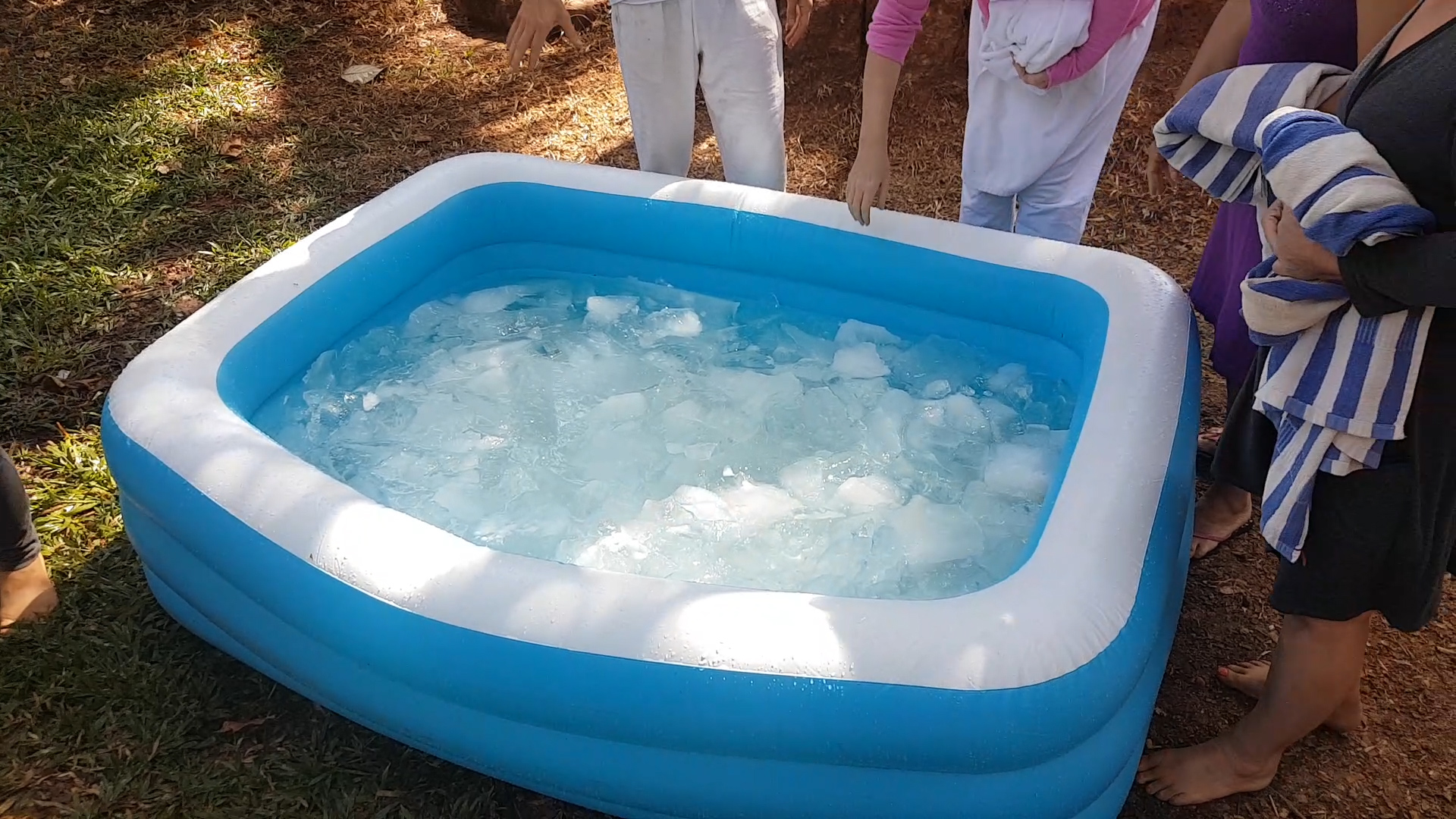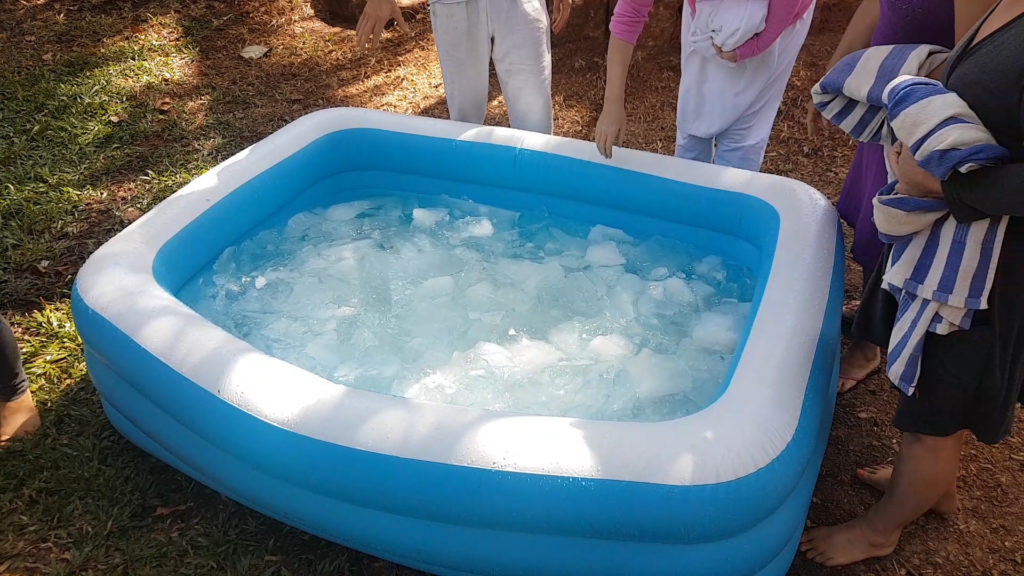
During the last seven days, on two separate occasions I have immersed myself in zero degree Celsius water, sinking below the white chunks of ice floating on the surface. Not exactly the typical experience you would expect when going to a yoga retreat in India, but I have been attending a yoga retreat with a difference!
The retreat was run by Isaac Mullins and as well as some fantastic, challenging, in depth yoga instruction, Isaac also introduced our group to Wim Hof breathing – including the famous ICE BATHS.

I had been familiar with Wim Hof’s work for some time, and have tried just a little of his breathing technique previously, using online resources, but this was my first opportunity to go deep into the technique with a qualified instructor.
If you don’t know who Wim Hof is, you may have been hiding under a rock for the last few years. Wim Hof, also known as The Iceman, is a Dutch extreme athlete who has been attracting quite a lot of attention and media coverage with his sub-zero exploits. In March 2000 he set the Guinness World Record for the longest distance swum under ice, with a swim of 57.5 metres in a frozen lake in Finland. Other feats he is famous for include record times in tubs surrounded by ice, and climbing snowy mountains wearing nothing but shorts and shoes.
According to Wim, at the heart of his ability to perform these impressive physical feats is a breathing technique he developed, and now promotes for both mental and physical/athletic performance, as well as to develop the immune system and overcome health problems. The technique itself is very simple, basically a series of fast deep breaths to induce a kind of controlled hyperventilation, followed by breath holding. If you would like to read more about Wim and his technique, there is quite a good Wikipedia article here, and his official website is here (https://www.wimhofmethod.com/).
What was my experience with the Wim Hof breathing method?
Well, many of the retreat participants experienced strong physical sensations while doing the breathing practice, and also various kinds of emotional release. For some it seemed to be deeply beneficial. Also the ice baths were a significant mental challenge for some of the retreat participants, and each participant was able to go further into the water, or stay in for longer as the retreat progressed.
My own experience on the other hand… well, it wasn’t as dramatic. The first time I did the technique I felt nothing out of the ordinary. The second time, I tried making some small changes to how I performed the breathing, and by the fifth round of hyperventilation and breath holding I felt some mild sensations of energy (or qi) flowing to my hands, and also some extra energy activity in my head. Each subsequent session, I tried to make further adjustments, talking with Isaac about how I might be able to gain more from the practice, and each time I was able to generate a little more energy with the breathing technique, but the energy flow was still mild, still really nothing out of the ordinary for me as I am used to generating quite strong currents of energy in my qigong practice. And the ice baths? Well the first day everyone was only staying in for two minutes at a time (or less), so that is what I did then. The next time we had more flexibility to stay longer, so I was in for ten minutes feeling quite comfortable before getting out because, well it was getting a bit boring for everyone else watching and waiting.
So overall, I found the effects a bit underwhelming. None of this is a reflection on Isaac’s teaching. I think he did a great job of taking everyone through the technique, dealing with any issues that arose, and being mindful of safety at all times, including even of myself when in the ice bath, which I think is quite important when exploring relatively extreme techniques such as this one. So I think we need to look a bit further at the technique itself.
What is my opinion of the Wim Hof technique?
I think the reason that Wim Hof’s technique stands out is that it utilizes the two most yang or active phases of breathing stimulation – hyperventilation and breath holding. While there is a lot of talk and promotion of the technique as stimulating the parasympathetic nervous system (yin), it does this by pushing hard into yang territory until the seed of yin is found. This is a refreshing approach contrasted to what is commonly taught these days, which is usually all about avoiding the yang aspects of breathing, and focusing purely on the yin aspects – ie, breathing with the abdomen and not the chest, breathing slowly, using only the nose, etc. One classic example of this is the Buteyko method, which focuses on underbreathing as a way to avoid potential harmful effects of habitual hyperventilation. In my opinion this approach to breathing is stifling and restrictive and does not allow someone to gain the full benefit and power of their breath.
Wim Hof’s method of hyperventilation is a powerful counterpoint to this which embraces the power of the breath fully, encouraging deep and strong breathing, and medical science is starting to back up his claims of the benefits of his breathing style. His extreme exploits have attracted a lot of attention, including from the scientific community, and the evidence they have gathered about the benefits of controlled hyperventilation will hopefully filter through the collective consciousness and put to bed the excessive caution around this aspect of breathing.
But in the end, it’s a bit of a one trick pony. The technique really just focuses on one aspect of the breath, and as such is rather limited in its potential usefulness, both for physical performance and self discovery. It also lacks the nuance that could help practitioners to go much further and achieve much more with their breathing practice.
Sometimes simplification is necessary to catch people’s attention, and deliver an easily communicated message to the masses. And I think that was the case in this instance. Having such a simplified technique such as Wim Hof’s makes it easy to teach to complete beginners, easy to study scientifically, and easy for the mass media to get behind. I applaud Wim for the work he has done in this area, and the attention and interest he has drawn to the potential benefits of working with the breath. I hope that at some point this interest will lead people to look further as well though.
There is so much more benefit that can be gained and understanding that can be derived by looking more deeply into breathing practices. To really understand yourself, and utilize the full potential of your breath, I believe you need to be familiar and comfortable with all phases of the breathing stimulation cycle. Also, there is one crucial element that allows you to take these benefits much further than Wim’s method allows, and that is connection of the mind to the bodies energy through active awareness and intention. Traditional breathing techniques contain all of this. The traditional technique that Wim Hof’s method bears the greatest similarity to is called Tummo, and involves not just breathing, but actively using the mind and intent to generate heat. The classic test of this was to sit in the snow with a wet blanket on you, and generate enough heat to dry the blanket. This is a more nuanced practice. Developing the link between the mind and body in this way takes some practice, but it opens up limitless possibilities.
While I have not had much previous experience with cold exposure, I do have a lot of experience directing energy with my mind and with my breath in qigong practice, and I believe it was this that made the effects of the Wim Hof breathing method seem mild to me, and the ice bath not particularly challenging. Because my body is used to generating strong flows of energy (qi), the effect of just the breath was relatively mild in comparison. I am also already comfortable with the yang aspects of the breath, because my practice includes working with all the phases, both yin and yang. Understanding these phases allows me to be adaptable and breathe in the most suitable way for the situation I find myself in, and my objectives in that situation. When I also combine intention with my breath, it becomes a source of great power that I can direct and use to accomplish my goals.
It is my hope that Wim Hof’s promotion of breathwork to the world will help people to look even further and discover these deeper layers and greater potentialities of the breath.
Have you experienced the Wim Hof method? If so I would be curious to hear your experience or opinions in the comments below, particularly if you come from a background where you have experienced other types of breathwork.
If you are interested in some of the breathing that I teach, you can check out the Release the Power of your Breath course here. Not quite as attention grabbing as Wim Hof’s sub zero exploits, but you will learn a variety of breathing practices that will help you to develop skill with your breath for every situation, as well as gaining a better understanding of yourself. We have a group starting the course soon, you can check out dates here.
4 Comments. Leave new
Very interesting video about Wim Hof Breathing John, thank you so much.
I was practicing this method when I visited a hot mineral bath resort in Ainsworth, British Columbia, Canada. Next to the hot mineral pools was an ice cold bath of water flowing down from the mountains. I started with just walking in and out of the bath because IT WAS COLD! Gradually over a few days, through Qigong meditation and energy practices, I was able to stay in the cold water longer and longer working up to about 6 minutes. When I got out of the cold water I could not feel the cold air at all. And when I got in the hot mineral water it felt like little needles. Any pain I had was gone, (maybe it froze), and I was exhilarated and energized. Not sure it is something I am going to practice on a daily basis but it truly was a practice of mind over matter. There was a family from Sweden at the resort and they stayed in the cold water for up to 20 minutes without any issues at all. It seemed as easy for them as staying in the hot water. Hmmm.
Yeah, there is a lot of value in hot and cold therapy. Really useful when applied in the right way.
I have also done some Wim Hof method instructed breathing and it felt similar to the energizing breath or Breath of Fire from Kundalini yoga. I agree that it didn’t do much for me and exploring the full ranges of breathing are very important. Being a meditation master and Qigong instructor I have worked for 25+ years with the breath and there are a lot of techniques that work to embrace wider aspects of the body, mind, and QI through the breath. But if it works for him and others, that’s fine. *YOUR course on breathing is fantastic and I highly recommend it to everyone. It is quite comprehensive.*